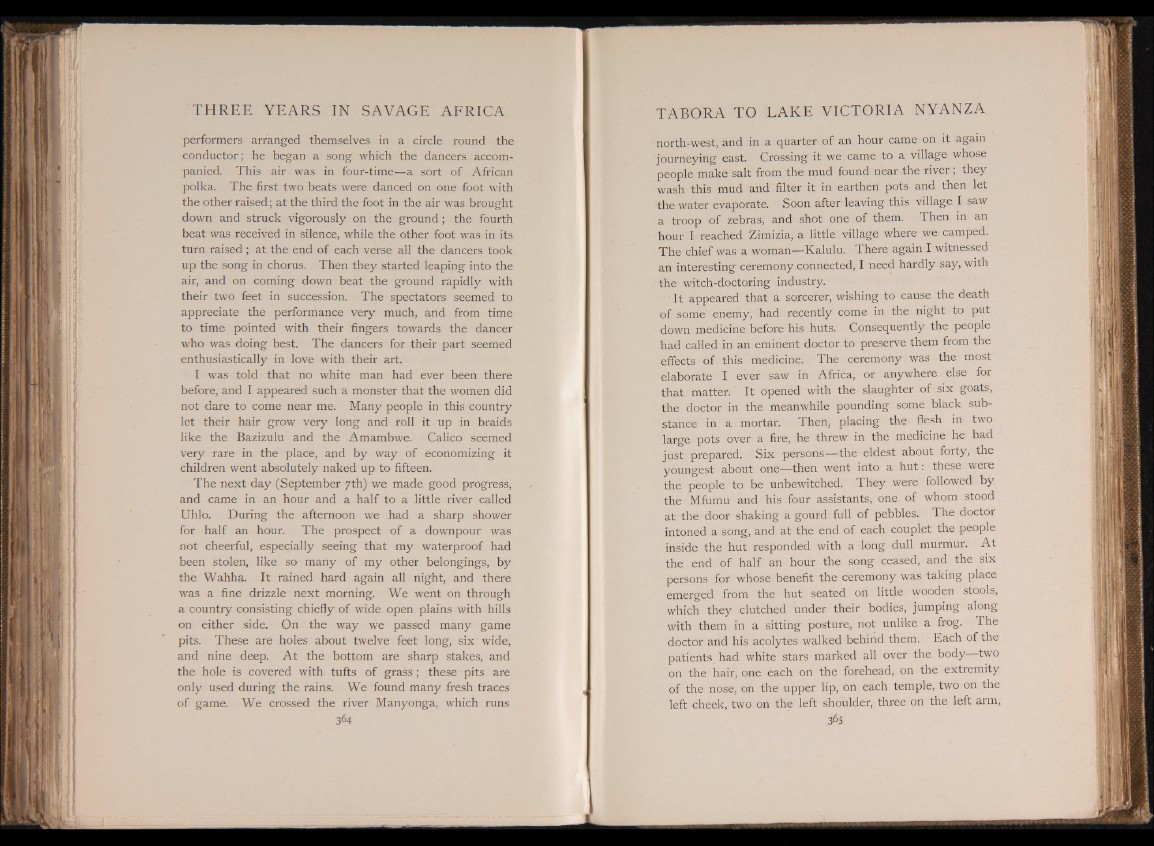
performers arranged themselves in a circle round the
conductor; he began a song which the dancers accompanied.
This air was in four-time—a sort of African
polka. The first two beats were danced on one foot with
the other raised; at the third the foot in the air was brought
down and struck vigorously on the ground; the fourth
beat was received in silence, while the other foot was in its
turn raised ; at the end of each verse all the dancers took
up the song in chorus. Then they started leaping into the
air, and on coming down beat the ground rapidly with
their two feet in succession. The spectators seemed to
appreciate the performance very much, and from time
to time pointed with their fingers towards the dancer
who was doing best. The dancers for their part seemed
enthusiastically in love with their art.
I was told that no white man had ever been there
before, and I appeared such a monster that the women did
not dare to come near me. Many people in this country
let their hair grow very long and roll it up in braids
like the Bazizulu and the Amambwe. Calico seemed
very rare in the place, and by way of economizing it
children went absolutely naked up to fifteen.
The next day (September 7th) we made good progress,
and came in an hour and a half to a little river called
Uhlo. During the afternoon we had a sharp shower
for half an hour. The prospect of a downpour was
not cheerful, especially seeing that my waterproof had
been stolen, like so many of my other belongings, by
the Wahha. It rained hard again all night, and there
was a fine drizzle next morning. We went on through
a country consisting chiefly of wide open plains with hills
on either side. On the way we passed many game
pits. These are holes about twelve feet long, six wide,
and nine deep. At the bottom are sharp stakes, and
the hole is covered with tufts of grass; these pits are
only used during the rains. We found many fresh traces
of game. We crossed the river Manyonga, which runs
north-west, and in a quarter of an hour came on it again
journeying east. Crossing it we came to a village whose
people make salt from the mud found near the river , they
wash this mud and filter it in earthen pots and then let
the water evaporate. Soon after leaving this village I saw
a troop of zebras, and shot one of them. Then in an
hour I reached Zimizia, a little village where we camped.
The chief was a woman—Kalulu. There again I witnessed
an interesting ceremony connected, I need hardly say, with
the witch-doctoring industry.
It appeared that a sorcerer, wishing to cause the death
of some enemy, had recently come in the night to put
down medicine before his huts. Consequently the people
had called in an eminent doctor to preserve them from the
effects of this medicine. The ceremony was the most
elaborate I ever saw in Africa, or anywhere else for
that matter. It opened with the slaughter of six goats,
the doctor in the meanwhile pounding some black substance
in a mortar. Then, placing the. flesh in two
large pots over a fire, he threw in the medicine he had
just prepared. Six persons—the eldest about forty, the
youngest about one—then went into a hut: these were
the people to be unbewitched. They were followed by
the Mfumu and his four assistants, one of whom stood
at the door shaking a gourd full of pebbles. The doctor
intoned a song, and at the end of each couplet the people
inside the hut responded with a long dull murmur. At
the end of half an hour the song ceased, and the six
persons for whose benefit the ceremony was taking place
emerged from the hut seated on little wooden stools,
which they clutched under their bodies, jumping along
with them in a sitting posture, not unlike a frog. The
doctor and his acolytes walked behind them. Each of the
patients, had white stars marked all over the body two
on the hair, one each, on the forehead, on the extremity
of the nose, on the upper lip, on each temple, two on the
left cheek, two on the left shoulder, three on the left arm,
365